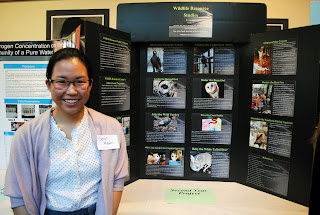The Wildlife Resources department is pleased to announce that it recently added a Peregrine Falcon named "Endeavour" to its collection!

(photo by Traci Lambert - click to enlarge)
Endeavour arrived just a few weeks ago from a wildlife rehabilitation center in the state of Washington, where she was deemed to be non-releasable due to visual impairment. She is not able to see well enough to hunt on her own. Her eyes are structurally sound so the problem is with her nervous system, most likely the result of a trauma. We are currently assuming that Endeavour is a female based on her size compared to our known male. Peregrine Falcon females are usually considerably larger and stronger than the males. We plan to do a blood test in the spring to confirm.
Endeavour has a dark chest right now since she is a juvenile. She will get her adult plumage at around one year of age. Peregrines can live up to 15-17 years in the wild and even longer in captivity, so we hope to have her for a very long time.
Peregrine Falcons are most famous for the speeds they reach during a hunt for prey. When they spot another bird, they will go into a stoop or dive reaching speeds of up to 200 mph. Even their normal flight is faster than most other birds at 62 mph. They are very adaptable and can be found on all continents except Antarctica. In fact their scientific name,
Falco peregrinus, means "wandering falcon." In the wild they nest on rocky cliffs but have also adapted to using tall buildings and bridges in cities.
The peregrine population was nearly wiped out east of the Mississippi river in 1968 due to the use of a chemical called DDT that weakened the shells of their eggs. In 1972 the use of DDT was restricted. In 1989 a program was started to reintroduce the falcons to Ohio. As a result they are now considered "threatened". As of last year, there were 36 known pairs at nesting sites in Ohio. 23 of those pairs produced a total of 59 juveniles.
If you would like to see a Peregrine Falcon up close please join us in the Perkins Wildlife Center where "Lou" is on display. Endeavour is going to be an education bird at CMNH. She is already quite good at stepping up on the glove so you may meet her taking a walk with one of our wildlife specialists. Once she is trained to go into a travel carrier she will be used in the educational programs.
Traci Lambert
CMNH Wildlife Specialist



